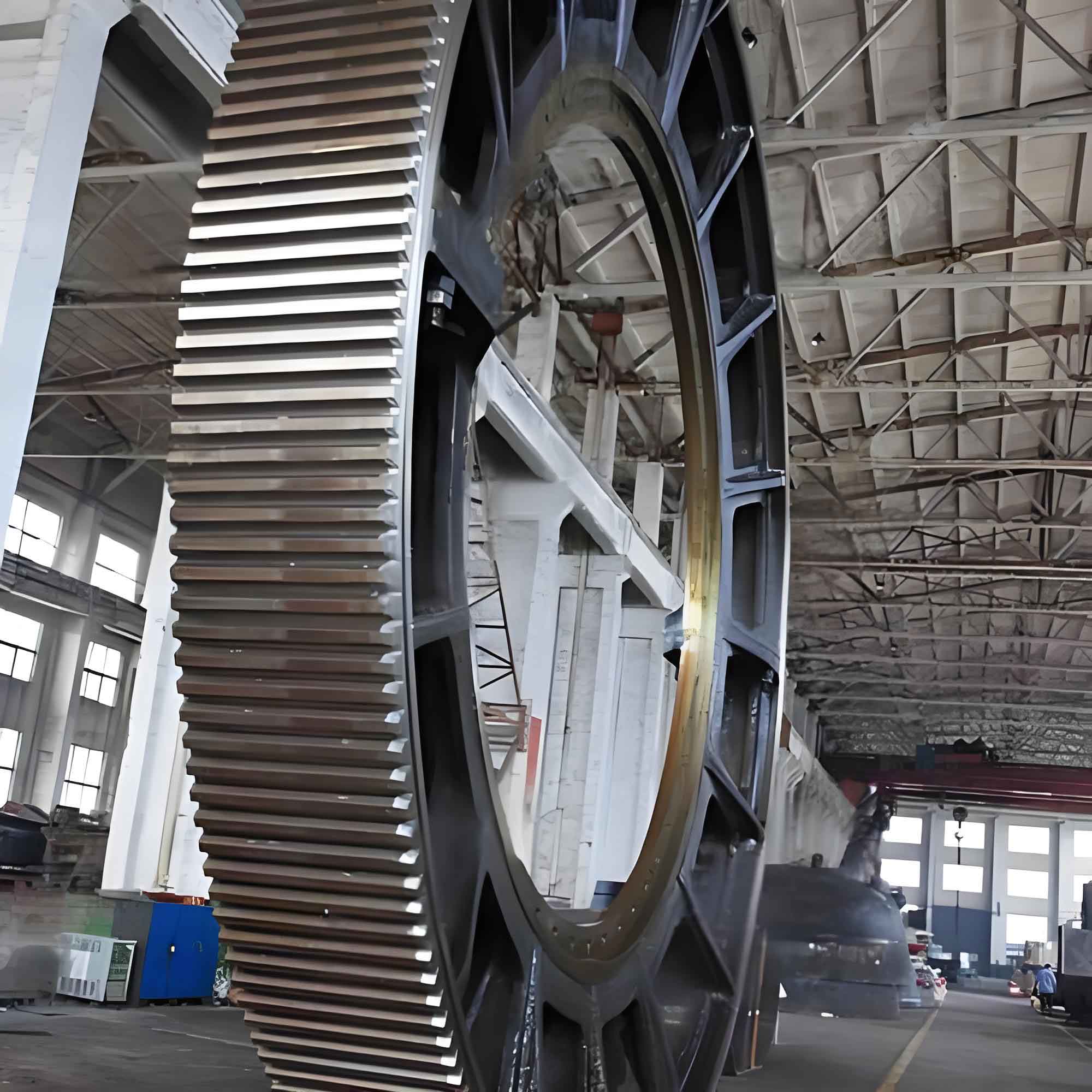In China’s 13th Five-Year Plan, marine engineering stands as a pivotal domain encompassing offshore cranes, drilling platforms, pipe-laying vessels, wind farms, and ship installations. These applications universally demand robust transmission systems centered around large gear mechanisms—specifically open gears deployed in critical equipment like cranes and winches. Given the marine environment’s harshness—characterized by saltwater corrosion, dynamic loads, and space constraints—gears must exhibit exceptional precision, durability, and lightweight design. Herringbone gears, distinguished by their dual-opposite-helix configuration, meet these stringent requirements more effectively than traditional spur gears, driving their adoption across marine sectors.

1. Marine Engineering and Large Herringbone Gear Manufacturing
1.1 Advantages of Large Herringbone Gears
Traditional spur gears used in marine settings typically exceed 2.5 meters in diameter. While simple to manufacture and free from axial thrust, their massive size, weight, and material consumption escalate costs. Herringbone gears—formed by integrating left- and right-handed helical gears with equal spiral angles—retain spur gears’ axial-load neutrality while amplifying benefits:
- Higher load capacity and contact ratio
- Smoother transmission dynamics
- Reduced width enabling compact design
- Lower weight and material use
The formula for contact ratio (\(\epsilon_{\gamma}\)) highlights this advantage:
$$\epsilon_{\gamma} = \epsilon_{\alpha} + \epsilon_{\beta}$$
where \(\epsilon_{\alpha}\) is the transverse contact ratio and \(\epsilon_{\beta}\) is the overlap ratio. Enhanced \(\epsilon_{\gamma}\) directly reduces vibration/noise—critical in marine operations.
| Parameter | Spur Gear | Herringbone Gear |
|---|---|---|
| Axial Load | None | None |
| Transmission Stability | Moderate | High |
| Weight (Typical) | 100% (Baseline) | 60-70% |
| Material Cost | High | Reduced by 25-30% |
| Space Requirement | Large | Compact |
1.2 Manufacturing Process for Large Herringbone Gears
Herringbone gears are monolithic or segmented cylinders with mirrored helical teeth. Marine-grade variants use 34CrNi1Mo alloy steel with strict specifications:
- Module (m): 28–36 mm
- Helix angle (\(\beta\)): 20–28°
- Surface hardness: 240–280 HB
- Left/right flank cumulative pitch error: <0.1 mm
Manufacturing thin-walled, large-diameter segments requires stringent deformation control during heat treatment and machining. The optimized workflow is:
- Forging/Ring rolling → 2. Normalizing → 3. Rough turning → 4. NDT inspection → 5. Rough hobbing → 6. Quenching/tempering → 7. Semi-finish turning → 8. Flaw detection → 9. Positional marking → 10. Drilling → 11. Finish turning → 12. Same-helix assembly → 13. Finish hobbing → 14. Disassembly → 15. Opposing-helix assembly → 16. Precision reaming → 17. Magnetic particle inspection.
Normalizing refines grain structure pre-tempering, while rough hobbing pre-shapes teeth to enhance post-heat-treatment root strength. Intermediate turning operations counteract thermal distortion during drilling.
2. Critical Manufacturing Technologies
2.1 Ring Rolling vs. Open-Die Forging
Conventional open-die forging for large gear blanks consumes excessive material and incurs high machining costs. Ring rolling—a progressive forming method—offers superior efficiency:
$$\text{Material Savings} = \left(1 – \frac{W_{\text{ring}}}{W_{\text{open-die}}}\right) \times 100\% \approx 25\%$$
where \(W\) represents blank weight. A radial-axial ring mill (e.g., SMS GmbH’s 9m-capacity systems) deforms the workpiece between a driven roll and idling mandrel, reducing thickness while expanding diameter to near-net shape.
| Variable | Value Range | Impact |
|---|---|---|
| Roll Force (kN) | 800–12,000 | Determines final density |
| Feed Rate (mm/s) | 1–10 | Controls grain flow |
| Temperature (°C) | 1050–1150 | Prevents cracking |
2.2 Heat Treatment Precision
Tempering achieves uniform tempered sorbite microstructure, balancing hardness (240–280 HB) and toughness. For thin-walled large gear segments, furnace control is paramount:
$$\text{Temperature Uniformity} = \max(T_{\text{top}}, T_{\text{bottom}}, T_{\text{center}}) – \min(\cdots) \leq 5^\circ \text{C}$$
Critical protocol:
- Quenching: 860±5°C × 6 hrs → Water-soluble polymer cooling
- Tempering: 630±5°C × 12 hrs → Air cooling
Workpiece support flatness (<0.05 mm/m) and load distribution prevent sagging during treatment. Industrial pit furnaces (45t capacity) with high-velocity circulators ensure thermal stability.
2.3 High-Efficiency Tooth Machining
Multi-segment simultaneous hobbing boosts productivity by minimizing tool approach/retract cycles. For batch production, face milling with indexable inserts provides aggressive material removal:
$$\text{Metal Removal Rate (MRR)} = f_z \cdot z \cdot n \cdot a_p \cdot a_e$$
where \(f_z\) = feed per tooth (mm), \(z\) = insert count, \(n\) = spindle speed (rpm), \(a_p\) = axial depth (mm), and \(a_e\) = radial width (mm). MRR gains of 40–60% versus conventional hobbing are achievable.
2.4 Assembly Tolerance Control
Precision pairing of left/right helices demands:
- Selection of gear pairs with matched base tangent lengths (\(W_k\))
- Deburring and cleaning of contact surfaces
- Laser-aligned centering (±0.05 mm runout)
- Bolt preloading to specified torque \(T\):
$$T = K \cdot d \cdot F_{\text{preload}}$$
where \(K\) = friction coefficient (0.2 for lubricated steel), \(d\) = bolt diameter, and \(F_{\text{preload}}\) = target clamp force. Post-assembly, final reaming ensures hole positional accuracy ≤ IT7 grade.
3. Conclusion
Large herringbone gears are indispensable in marine engineering—enabling compact, high-torque transmission for cranes, winches, and propulsion systems. Advanced manufacturing techniques like ring rolling, controlled tempering, multi-part hobbing, and precision assembly have overcome historical limitations in weight, cost, and noise. Future advancements will focus on integrated surface hardening (e.g., induction hardening) to further enhance durability in corrosive marine environments. As China expands its offshore capabilities, optimized large gear production remains foundational to maritime infrastructure success.
